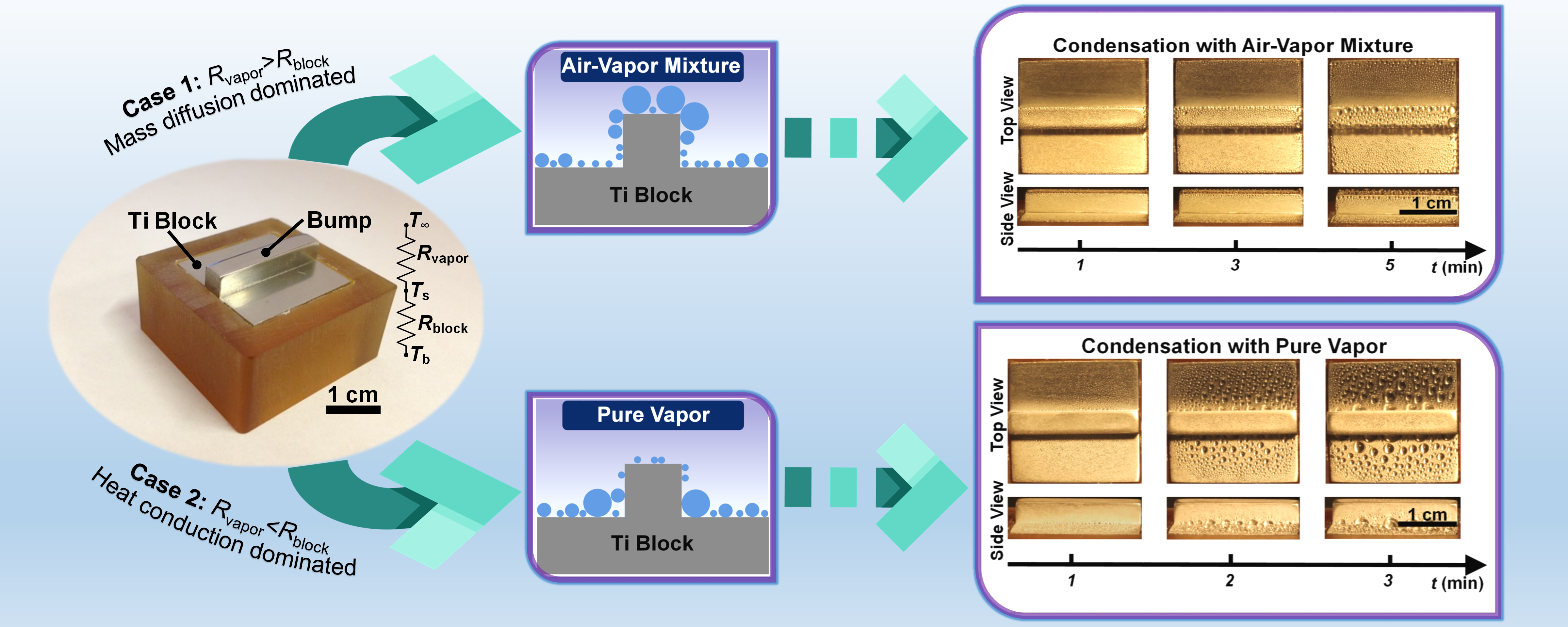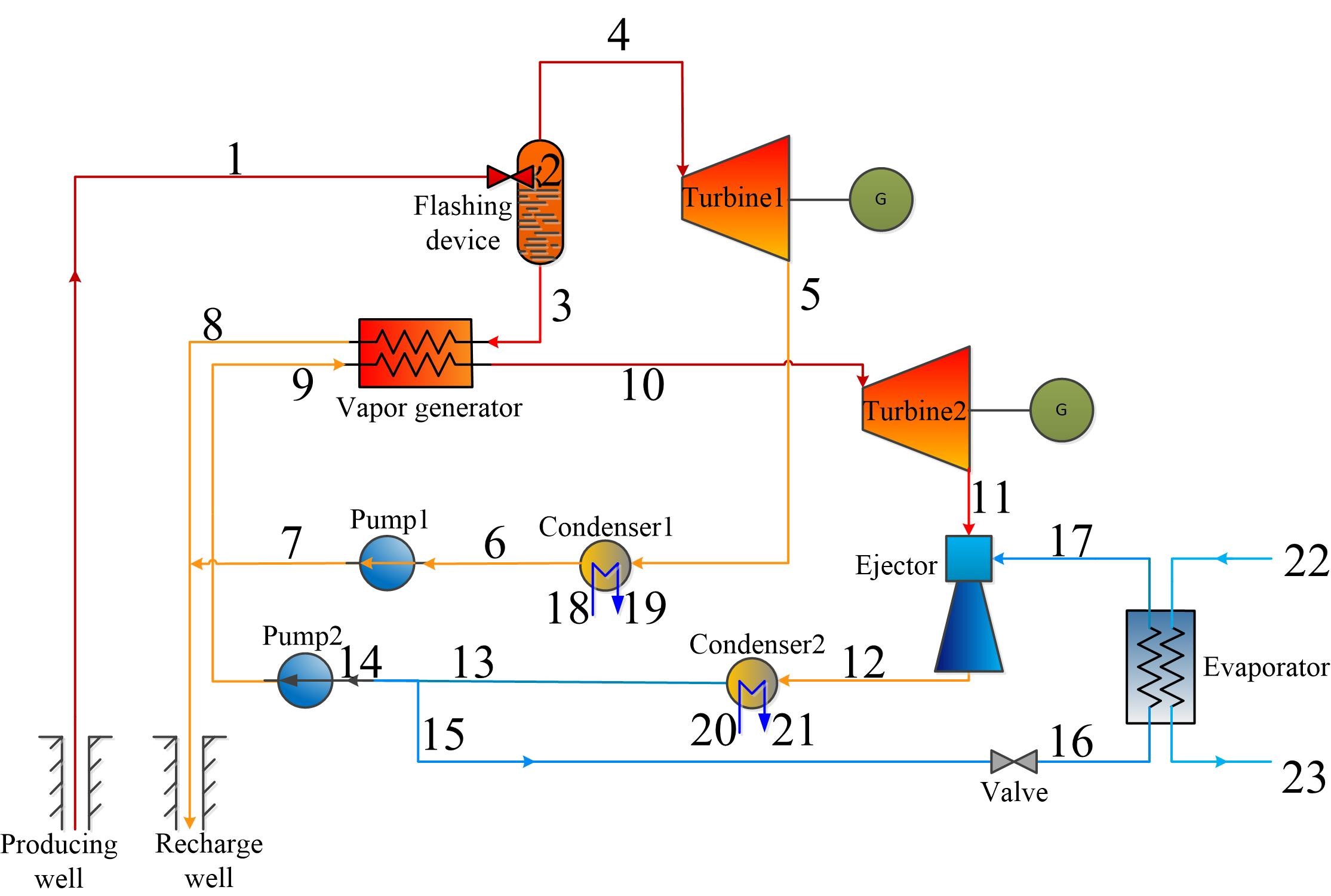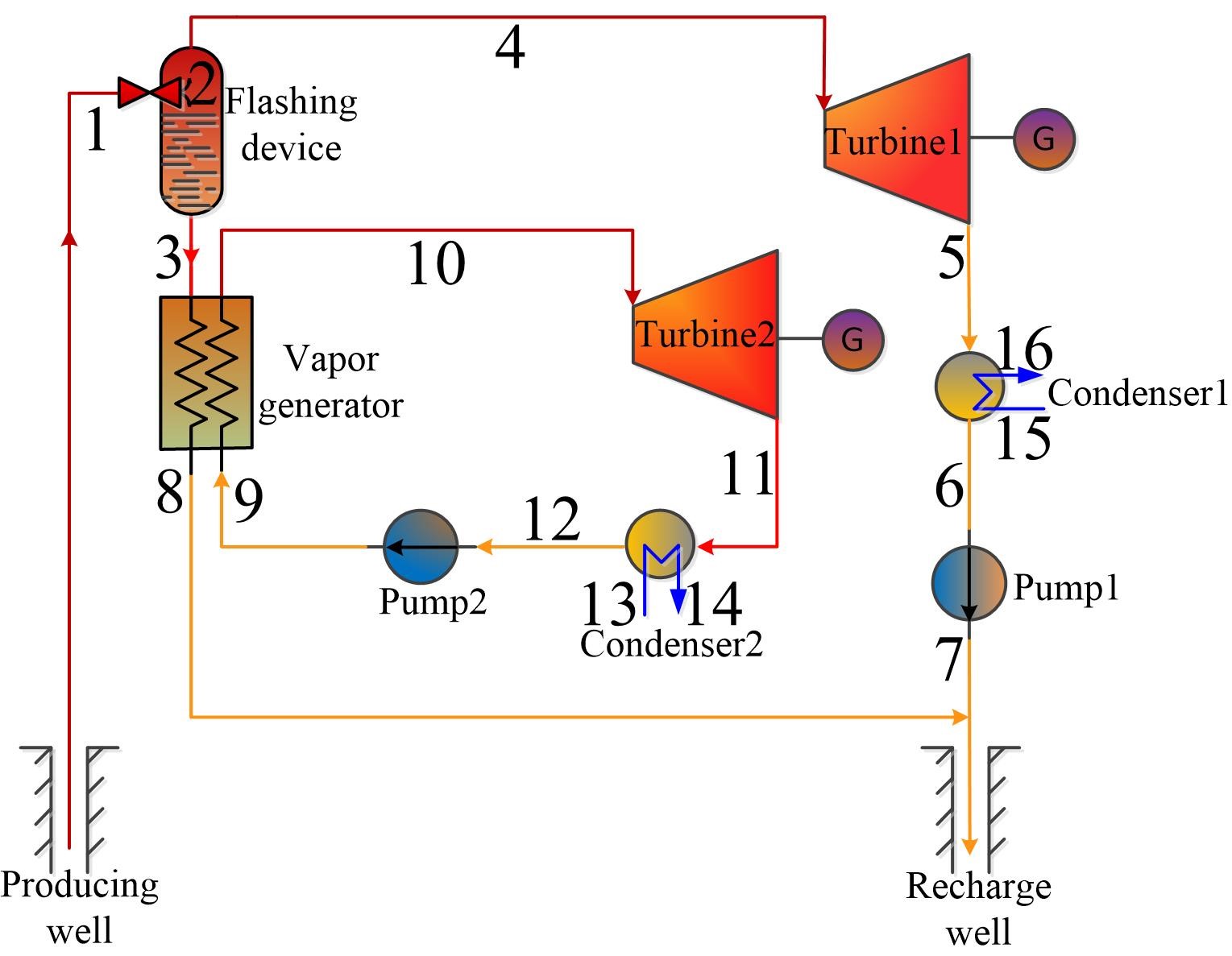Yajing Zhao
Research
Dropwise Condensation on Millimetric Geometric Features
Condensation is a ubiquitous process often observed in nature and our daily lives. The large amount of latent heat released during water condensation has been harnessed in many inductrial processes such as power generation and thermal management. Condensation has two modes: dropwise mode and filmwise mode. It has been well known that dropwise mode has better heat transfer performance as compared to filmwise mode, attributed to the fast removal of condensates through droplet shedding. Recent studies have shown that the combination of millilmeter sized geometric features and plain hydrophobic coatings can effectively manipulate droplet distribution of water condensates. Our experimental results show that, although convex structures enable faster droplet growth in an air-vapor mixture, the same structures impose the opposite effect during pure vapor condensation, hindering droplet growth. We developed a model for each case to predict the heat flux distribution along the structured surface, and the model shows reasonable agreement with experimental results. This work demonstrates that the effects of geometric features on dropwise condensation are not invariable but rather dependent on the scenario of resistances to heat and mass transfer in the system. The fundamental understanding developed in this study provides useful guidelines for condensation applications including power generation, desalination, dew harvesting, and thermal management.

Y. Zhao, D. J. Preston, Z. Lu, L. Zhang, Y. Queeney, E. N. Wang International Journal of Heat and Mass Transfer 119, 931-938, 2018. Exploitation of renewable energy plays an important role in the security of energy supply for a long term. Among all kinds of renewable energies, geothermal energy has abundant amount of storage as well as significant base-load potential. Variety of thermal systems have been developed to utilize geothermal sources of different temperatures. Particularly, for geothermal sources with temperature below 180°C where direct flashing processes are no longer feasible, organic Rankine cycles (ORC) have been applied as reliable technologies for exploiting low-temperature geothermal energy. In this project, we developed two geothermal systems based on organic Rankine cycles: one is a combined cooling and power geothermal system, another is a flash-binary geothermal system. In order to evaluate the comprehensive performance of the geothermal systems, we developed a exergoeconomic indicator, namely the average levelized costs per unit of exergy products for the overall system, which combines the pespectives of both economics and thermodynamics. Based on the system performance indicator, we carried out parametric analysis and system optimization for the two geothermal systems we developed. For both case studies, the optimization results reveal that, the most exergoeconomically efficient system could not obtain the best system thermodynamic performace and vice versa; in exergoeconomics the significant improvement in system's economy is at the expense of the slight diminishment in system's thermodynamic performance. The exergoeconomic analysis developed in this project provide comprehensive understanding of geothermal systems as well as useful guidelines for designers.
The CCP geothermal system combines the flash-binary power generation system with the combined cooling and power subsystem, which can produce both power and refrigeration simultaneously. The geothermal water exploited from the producing well with high temperature and high pressure is delivered to a flashing device, where the flash process occurs in the inlet to the cyclone separator as a result of a throttling process induced by a control valve. After the flash process, the two-phases of geothermal water are separated into steam stream and brine stream. The steam stream is used to drive the steam turbine (turbine 1) to produce power.
The flash-binary geothermal power system combines the single flash steam power generation system (top) with the ORC subsystem (bottom), which can produce both power by both turbines operating at different conditions. Geothermal water exploited from the producing well with high temperature and high pressure is delivered to a flashing device,
Y. Zhao, J. Wang Applied Energy 179, 159-170, 2016 Y. Zhao, J. Wang, L. Cao, Y. Wang Energy 97, 470-487, 2016
Related Papers
Effects of millimetric Geometric Features on Dropwise Condensation under Different Vapor Conditions
Organic Rankine Cycle Systems Driven by Geothermal Energy
Combined Cooling and Power (CCP) Geothermal System
 The brine stream enters a vapor generator to drive the bottom combined cooling and power subsystem that combines an organic Rankine cycle with an ejector refrigeration cycle. The high pressure and temperature vapor of the organic working fluid generated in the vapor generator is expanded through the ORC turbine (turbine 2) to produce power. The ORC turbine exhaust as the primary fluid enters the ejector, entrains secondary fluid from the evaporator into the ejector, and then mixes with the secondary fluid. The mixed stream from the ejector is delivered to the condenser 2 where it condenses to liquid by rejecting heat to the surroundings. One part of the working fluid leaving the condenser 2 enters the evaporator after passing through the throttle valve, and then be vaporized by absorbing heat from the cooled media to produce cooling effect. The other part flows to the pump 2 where it is pumped to the vapor generator to be vaporized again.
The brine stream enters a vapor generator to drive the bottom combined cooling and power subsystem that combines an organic Rankine cycle with an ejector refrigeration cycle. The high pressure and temperature vapor of the organic working fluid generated in the vapor generator is expanded through the ORC turbine (turbine 2) to produce power. The ORC turbine exhaust as the primary fluid enters the ejector, entrains secondary fluid from the evaporator into the ejector, and then mixes with the secondary fluid. The mixed stream from the ejector is delivered to the condenser 2 where it condenses to liquid by rejecting heat to the surroundings. One part of the working fluid leaving the condenser 2 enters the evaporator after passing through the throttle valve, and then be vaporized by absorbing heat from the cooled media to produce cooling effect. The other part flows to the pump 2 where it is pumped to the vapor generator to be vaporized again.
Flash-binary Geothermal Power System
 where the flash process occurs in the inlet to the cyclone separator as a result of a throttling process induced by a control valve. After the flash process, the two-phases of geothermal water are separated into steam stream and brine stream. The steam stream is used to drive the steam turbine (Turbine 1) to produce power while the brine stream enters a vapor generator to drive the bottom ORC subsystem. In the vapor generator, the organic working fluid absorbs heat and becomes superheated vapor. The superheated vapor enters the ORC turbine (Turbine 2) and expands to a low pressure to produce power. Afterwards, the ORC turbine exhaust is condensed to liquid in condenser 2 by rejecting heat to the surroundings. Liquid organic fluid from condenser 2 flows to pump 2 where it is pumped to the vapor generator to be superheated again. In addition, the geothermal heat source after exploitation is finally reinjected into the recharge well.
where the flash process occurs in the inlet to the cyclone separator as a result of a throttling process induced by a control valve. After the flash process, the two-phases of geothermal water are separated into steam stream and brine stream. The steam stream is used to drive the steam turbine (Turbine 1) to produce power while the brine stream enters a vapor generator to drive the bottom ORC subsystem. In the vapor generator, the organic working fluid absorbs heat and becomes superheated vapor. The superheated vapor enters the ORC turbine (Turbine 2) and expands to a low pressure to produce power. Afterwards, the ORC turbine exhaust is condensed to liquid in condenser 2 by rejecting heat to the surroundings. Liquid organic fluid from condenser 2 flows to pump 2 where it is pumped to the vapor generator to be superheated again. In addition, the geothermal heat source after exploitation is finally reinjected into the recharge well.
Related Papers
Exergoeconomic analysis and optimization of a flash-binary geothermal power system
Comprehensive analysis and parametric optimization of a CCP (combined cooling and power) system driven by geothermal source